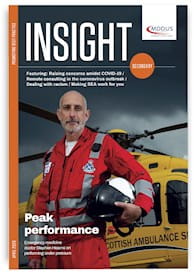
ALL secondary care teams should be following nationally-led and organisationally-driven systems of reporting and learning from adverse events. In theory, these should be effective in reducing risk, but in practice there are often process failures. And with under-reporting common, it becomes impossible to maximise the value of the exercise.
The most common factor in under-reporting is that the incident isn’t perceived as “adverse”. At MDDUS training events, we often hear comments such as: “there’s no point in reporting incidents as you never get any feedback and nothing changes”, or “my colleagues don’t always report incidents as there is a worry that we won’t be supported”.
If you want to start a conversation in your team – at all levels and including clinical governance leads – below are some starting points.
HOW ARE EVENTS TARGETED FOR ANALYSIS?
Consider the effectiveness of your incident reporting processes. If you are a clinical lead, does the team understand what a reportable incident is? Are different teams reporting into the same multidisciplinary process? Does everyone understand the purpose of collecting, and the process that follows?
Are low-level incidents, near misses and ‘good catches’ being collected as well as more significant incidents for thematic review? Capturing such incidents can help identify training needs and reduce unnecessary follow-up activities.
Leads, and the clinical governance team, should also consider who reports incidents. Are the same people reporting all the time, or do incidents cover the full range of team activities? Does your organisational culture support self-reporting? Staff who feel unsupported are also unlikely to report an incident in which they were involved. Staff who feel bullied or intimidated by senior staff are unlikely to report incidents involving those individuals.
Most organisations have a clinical governance team who deal with incident reports. Often their time is taken up with more serious events, and clearly this is important. However, pattern analysis of frequent/lower level incidents and near misses can provide solutions to improve routine systems or protocols. If you are a team lead, can you access this information and use it to create positive changes?
Highlighting efficiencies and safer protocols adopted as a result of such reporting can encourage future engagement. Reviewing the ease of reporting is also important: achieving a balance between simplicity and gathering sufficient data is crucial.
WHO IS INCLUDED IN INCIDENT ANALYSIS?
Some clinical incidents may be too sensitive for wider team discussion. But if incidents involve non-clinical systems – or patient-related processes in which admin actions are required – a suitable admin team member must be involved to ensure that any changes are sensible and do not create additional risks. Alternatively, outcomes can be shared via team meetings or other agreed channels. Either way it is important to ensure changes are properly understood (and embraced) by the wider team and other stakeholders, such as other departments, locations or relevant patient groups.
Teams who are proactively running multidisciplinary incident analysis meetings should ensure they include a range of topics or potential risks (errors) over a set period of time (e.g. a year cycle). This will ensure that no one group feels alienated or unengaged.
HOW ARE INCIDENT ANALYSIS MEETINGS STRUCTURED?
Taking a structured approach is essential when discussing adverse incidents, but being too structured may limit discussion beyond a few “high-level factors”. Staff may be reluctant to drill down into other contributing factors or feel pressured to “move on to the next agenda item”, particularly if more senior team colleagues move things along. There may also be a reluctance to express any implied (or implicit) criticism of others. A good chair should manage both the time spent on each agenda item and any differences in approach or ‘position’ by profession/specialty type, whilst ensuring that thorough questions are asked in each area of analysis.
It’s useful to collect as much information as possible beforehand in relation to the incident(s) to maximise the quality of discussion. This could include detailed written statements, copies of current policies or other records.
ARE STAFF SUPPORTED AND IS THE MOST COMPREHENSIVE LEARNING EXTRACTED?
In many cases only superficial learning and training opportunities are identified through analysis. What went wrong may be put down simply to: “the process or protocol wasn’t followed” or “the junior doctor should have asked for advice from a colleague at the time of the incident”. Subsequent learning is then noted as: “the protocol should be followed in these circumstances” or “in future a consultant should be contacted if a patient presents in this way”. Such conclusions may be true but unless “why” questions are asked many incidents are more likely to reoccur.
This is because in most scenarios there will be other underlying factors that contributed to the adverse incident, ranging across:
- People – the specifics of the patient or team member involved.
- Activities – the task(s) or process that the individual (or team) were engaged in at the time.
- Environment – the setting or situation within which the incident occurred.
There is evidence that asking “why” five times is the optimal strategy to achieve deeper learning and a root cause.
Exploring the contributory factors more fully should lead to findings such as: “the protocol was not followed because the individual was under too much pressure” or “the consultant was not contacted because the junior doctor was too scared to approach them”. In the latter, asking why is likely to identify whether the junior doctor needs support to be more assertive, or whether the consultant needs to adjust their manner or response to interruptions or contacts.
Identifying such underlying issues can often be challenging but failure to do so will likely lead to future incidents.
ARE OUTCOMES BEING MAXIMISED?
To ensure that any lessons learned from incidents are properly cascaded, a mechanism should be agreed through which staff not directly involved in an incident are updated. Any amendments to protocols or systems should include clear information about the efficiency, effectiveness or patient safety gain from the proposed change, as this is likely to encourage future compliance.
Sometimes, research or audit is required to assess the extent of any issues identified, or further training will be necessary to support improved practice. It is important to agree a timescale within which this should be completed, and to appoint an individual to make sure it happens and report back.
Once complete, an anonymised written record of the analysis – including insights gained, lessons learned and actions agreed – should be generated and retained securely. It is often useful to share this with the patient as part of a complaint response to show evidence of quality improvement. Where an event led or could have led to patient harm, an incident review can be used by doctors in appraisal/revalidation as evidence of reflective practice.
Doctors at all stages in their career have a responsibility to engage fully in patient safety initiatives and use whatever influence they have to effect positive change.
Liz Price is senior risk adviser at MDDUS
NATIONAL GUIDANCE
This page was correct at the time of publication. Any guidance is intended as general guidance for members only. If you are a member and need specific advice relating to your own circumstances, please contact one of our advisers.
Read more from this issue of Insight Secondary

Save this article
Save this article to a list of favourite articles which members can access in their account.
Save to library
